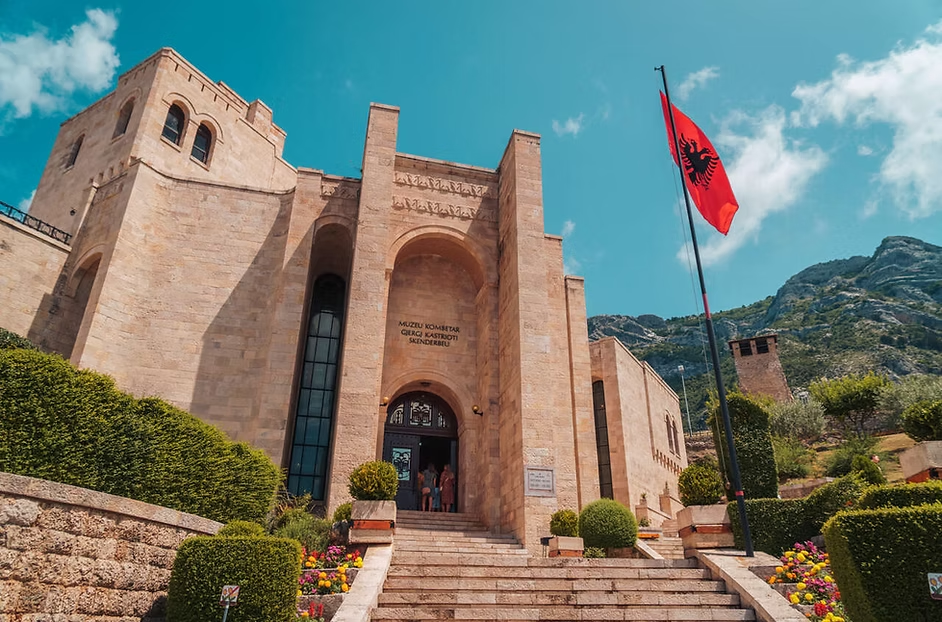
Key Takeaways
- The Castle of Kruja stands as a symbol of Albanian resistance and national pride.
- Its origins trace back to ancient Illyrian settlements, evolving through medieval influences.
- Skanderbeg’s legendary leadership transformed Kruja into a fortified hub of defiance against the Ottomans.
- The castle’s architecture showcases a blend of strategic design and cultural elements unique to Albania.
- Today, Kruja remains a vibrant cultural site, preserving Albanian heritage and attracting numerous visitors annually.
Table of contents
- Origins and Construction: A Journey Through Time
- The Castle in the Medieval Period: An Urban Fortress
- Skanderbeg and Resistance: The Heart of Albanian Courage
- Architectural Features: The Marvels of Design and Defense
- Cultural and Tourist Significance: Kruja’s Modern Appeal
- Kruja in Modern Albania: Preserving Legacy
Origins and Construction: A Journey Through Time
The Castle of Kruja has roots that stretch back centuries, enveloped in a mixture of myth and archaeological evidence. Evidence suggests the site was once part of an Illyrian settlement, making its origins deeply embedded in Albania’s ancient past. Over time, the fortress took shape mainly during the medieval period, influenced by powerful families such as the Thopia and Kastrioti, transforming it into a formidable defensive stronghold.
Medieval Development: Influential Dynasties
During the medieval era, the Castle of Kruja evolved into a key urban center, caught amidst the shifting power battles of feudal lords. Its strategic location made it a target for control by the Byzantine Empire, which intermittently sought dominance. Its resilient architecture withstood numerous sieges, cementing its role as a vital fortress of the region.
Feudal Lords and Historical Timelines
Under the influence of local noble families such as the Thopia and Kastrioti, the castle was transformed from a military garrison into a center of local administration. Its fortifications were expanded, with battlements combining functionality and aesthetic appeal—elements still visible today. For in-depth insights, explore resources like Library of Congress and Peter Prifti’s “History of Albania”.
The Castle in the Medieval Period: An Urban Fortress
Moving into the medieval age, the Castle of Kruja became more than just a fortress; it grew into a vibrant urban hub. It served as a seat of local governance and a cultural nucleus, reflecting the courage and resilience of the Albanian people. Inside its walls, artisans worked alongside civilians, fostering a lively community.
Byzantine Ties and Urbanization
The influence of the Byzantine Empire brought urban development to Kruja. The addition of chapels and administrative structures signified the merging of civil and military functions. As the city expanded under Byzantine rule, the castle symbolized prosperity and cultural unity. To explore this era further, see Harry Hodgkinson’s “Skanderbeg: A Biography”.
Skanderbeg and Resistance: The Heart of Albanian Courage
No discussion of Kruja is complete without honoring Gjergj Kastrioti Skanderbeg, the legendary Albanian hero who made Kruja his stronghold in resisting Ottoman expansion. His leadership and strategic mind turned Kruja into a fortress of defiance that would inspire generations.
Fortress of Resistance: Skanderbeg’s Legacy
Skanderbeg led the fortress through three major sieges between 1444 and 1478. His guerrilla tactics and diplomatic skills kept the Ottomans at bay with a smaller force. His legacy of resistance is etched into Albania’s national consciousness, exemplifying unwavering bravery. For more detailed analysis, visit Library of Congress.
Military Tactics and Albanian Bravery
Skanderbeg’s mastery of mountain and castle warfare showcased remarkable military strategy. The high ground and fortified towers made Kruja nearly impregnable, and his resilience remains an embodiment of Albanian courage.
Architectural Features: The Marvels of Design and Defense
Structure and Design: Elements of Power
The architecture of Kruja seamlessly marries natural terrain with human ingenuity. Its fortified walls, towers, and gates highlight both strength and strategic planning. The structures prioritized both defense and a commanding presence over the landscape.
Key Components and Towers
Prominent features include the main gate—an imposing curved entrance—along with the overlapping towers designed for maximum defense and visibility. The internal citadel and remnants of ancient houses reflect the castle’s layered history. The Skanderbeg Museum provides further insights and showcases the architecture’s grandeur.
Defensive Capabilities and Military Stronghold
The castle’s natural hilltop location offers a formidable defensive advantage. Its walls and strategic vantage points made it difficult for enemies to breach, exemplifying medieval military architecture at its finest.
Cultural and Tourist Significance: Kruja’s Modern Appeal
Today, Kruja is a pivotal symbol of Albanian identity and heritage. Visitors can explore the Skanderbeg Museum, the Ethnographic Museum, and enjoy sweeping panoramic views of the Albanian landscape. Its cobblestone streets and reconstructed sections immerse visitors in a medieval atmosphere.
National Identity and Cultural Heritage
The castle’s legendary role in resisting Ottoman rule has made it a core element of Albanian self-perception. Its stories, art, and folklore continue to inspire pride among Albanians and visitors alike.
Visitor Experience: Museums and Views
Walking through the castle’s stone streets, visitors can enjoy expansive views of the surrounding mountains and countryside. Guided tours through the Skanderbeg Museum and Ethnographic Museum help bring the history alive, making history tangible and engaging.
Accessibility and Visitor Information
Located just a short drive from Tirana, Kruja is accessible by car or public transportation. The site is open year-round with guided tours available. Check the Albanian National Tourism Agency or the Skanderbeg Museum website for updated hours, ticket info, and special events.
The Castle of Kruja in Modern Albania: Preserving Legacy
Preservation Efforts and Heritage Education
Numerous efforts by governmental and international agencies focus on maintaining the castle’s structural integrity and promoting awareness of its historical significance. Educational programs and restoration projects help ensure Kruja remains a living monument for future generations.
Events and Cultural Celebrations
Throughout the year, Kruja hosts festivals, reenactments, and cultural events that highlight Albanian traditions. These celebrations foster national pride and create engaging experiences for visitors, further connecting them to Kruja’s storied past.
Conclusion: The Enduring Legacy of Kruja
Exploring the Castle of Kruja reveals layers of history, architecture, and cultural resilience that define Albanian identity. This historic fortress exemplifies the spirit of resistance and pride that continues to inspire both locals and visitors.
To deepen your connection with Albanian heritage, consider visiting other notable sites like Butrint or Gjirokastër. Each offers a unique window into Albania’s past and present, inviting further exploration and appreciation.


0 Comment